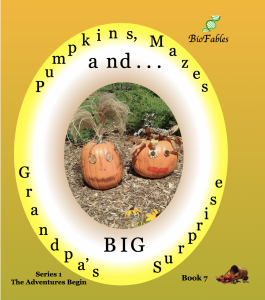
In early October, Northern Minnesota’s trees are dressed in shades of gold, orange, red, green and yellow. The setting sun that Friday evening made the colors look even sharper than they looked during the day.
Seven-year-old Melody and her twin brother Mallory, noses pressed against the windows of the eight-seat airplane, didn’t even realize that they had already landed at a small airport north of Duluth.
“Mel, look,” Mallory motioned to his sister. “Mal, look,” Melody said at the same time. Neither twin noticed that Grandpa Mike had stepped out of the cockpit of the rented eight-seat airplane and into the main cabin area.
Learning how leaves change colors in the fall, how to visualize the size of an acre, and how to use two sticks in a forest to figure out the direction you’re going (when you don’t have a compass) — these are just a small sampling of about a hundred mini-lessons awaiting readers of BioFables’ Book 7.
And that’s not counting Grandpa’s BIG surprise. We’re not telling, though. You’ll have to read Pumpkins, Mazes to find out.
BioFables children’s books focus on illuminating Sciences (STEM: Science, Technology, Engineering, Math) principles through fun stories. Parents, you know from experience that learning the subject matter that we call Sciences is a good first step. Understanding Humanities subjects helps us know how best to apply Sciences principles to the practical needs of the external world. And understanding one’s internal Values/Behaviors helps us to make things happen.
Every BioFables book weaves lessons derived from these interconnected (and often hidden) core disciplines into realistic stories that children relate to. Parents, you can use the free resources of this site to uncover those nearly-invisible lessons. They will help you prepare your children for happy, productive, rewarding and well-balanced lives.
If you’re ready to purchase Pumpkins, Mazes, please click on the Buy Pumpkins, Mazes icon to go directly to Barnes & Noble’s Pumpkin’s, Mazes page. (Your purchase of Pumpkins, Mazes helps support our ongoing efforts to continue expanding the wealth of this site’s free resources for homeschooling and all parents who are dedicated to the intellectual growth of their children)
If you’d like to learn more about using the considerable Pumpkins, Mazes resources at this site, please read on.
Pumpkins, Mazes Resources
The ten chapters in Pumpkins, Mazes contain nearly a hundred practical mini-lessons and pop-up lessons woven throughout Pumpkins, Mazes. We call these practical lessons Knowledge Nuggets. These Knowledge Nuggets contain specific information that readers can apply to their everyday lives. They may be in the form of a mini-lesson, with simple explanations of a specific concept, or as a quick, unplanned pop-up lesson.
Four sets of tables and lists in the Pumpkins, Mazes Knowledge Gateways page help you to place a given Knowledge Nugget within the greater realm of learning.
-
- Chapter-by-Chapter: Sciences, Humanities, Values/Behaviors
- Entire Pumpkins, Mazes: Sciences topics
- Entire Pumpkins, Mazes: Humanities topics
- Entire Pumpkins, Mazes: Values/Behaviors topics
Please visit Site Tips for even more ways to mine the wealth of information available on this site.

